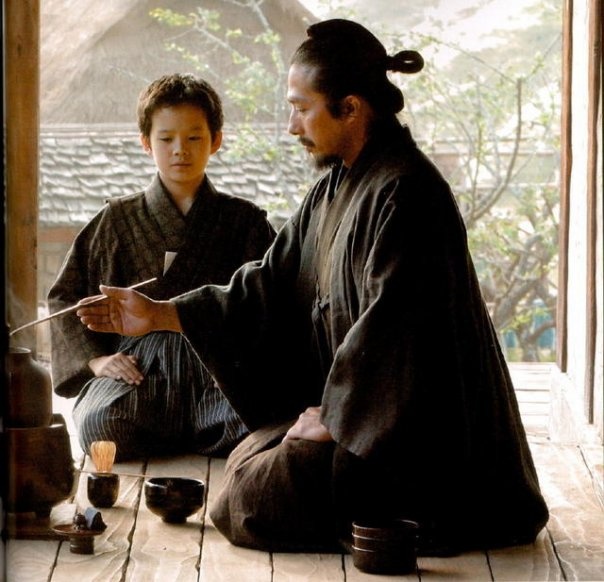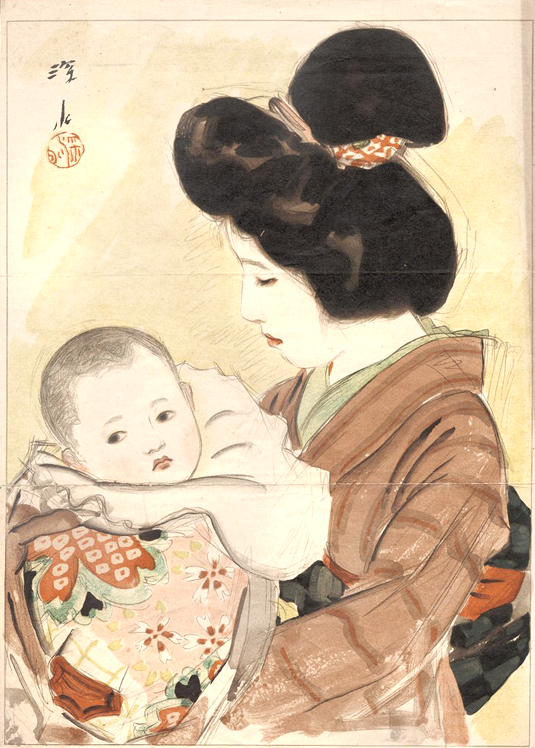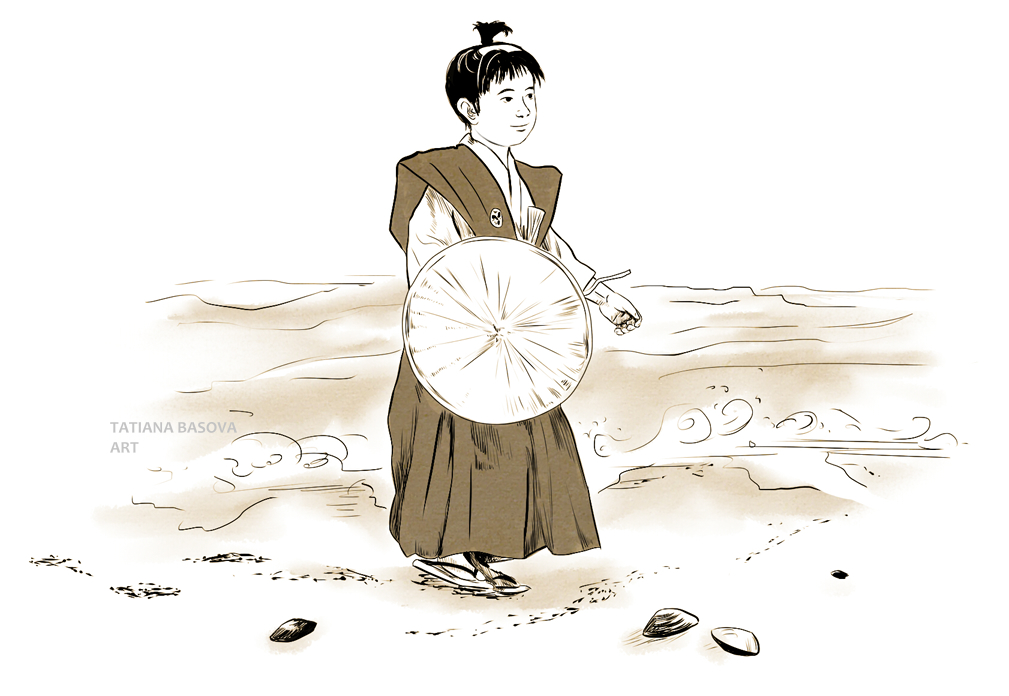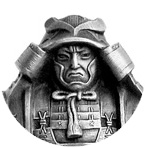Samurai Discipline
Childhood and samurai training
-

Whether a man becomes good or bad, clever or thick-witted, is simply a matter of the way he uses his mind. In this uncertain world, ours should be the path of discipline.
– Shiba YoshimasaEvery age has duties that must be remembered by the youth. To comprehend the Way of Valor, tell your children about the feats of great warriors. The most important thing is building a strong character, making them fearless. Sons should be raised by their fathers and follow in their footsteps. Fathers and sons should share a vibrant spiritual connection.
Naturally, the next generation was raised according to Bushi-Do spirit. Child-rearing was highly valued in samurai families, especially for sons who donned wooden swords as early as age five. From seven onwards, boys and girls were customarily brought up separately and even had to stay away from each other during meals. Many scholars have noted how serious samurai children were as a result of being denied childhood pleasures. Instead, they were ingrained with self-control, courage, consistency, perseverance and a rigorous attitude toward themselves and others. As Yamamoto Tsunetomo wrote in Hagakure, “There is a way of bringing up the child of a samurai. From the time of infancy one should encourage bravery and avoid trivially frightening or teasing the child…If a person is affected by cowardice as a child, it remains a lifetime scar…It is a mistake for parents to thoughtlessly make their children dread lightning, or to have them not go into dark places, or to tell them frightening things in order to stop them from crying. Furthermore, a child will become timid if he is scolded severely…One should not allow bad habits to form.”
The example set by the parents and samurai social circle was complimented by tales of Confucian morality and heroic samurai deeds, or gundan, as well as history. Samurai children were accustomed to danger, blood and death. They were not to be cowed by anything, whether they were witnessing executions, examining dead bodies, or participating in all-night vigils at cemeteries.

Rigorous challenges taught children that they had to be willing to die of exhaustion to fulfill their duties. The coming-of-age ceremony, or genpuku, illustrated this. Although the age of majority was not clearly defined in the Bushi-Do code, the young samurai underwent the ceremony between the ages of 12 and 15, at which point he was given a new adult name. Considered one of the most important moments in a samurai’s life, genpuku was usually held at night in a Shinto or Buddhist shrine where a patriarch or guest of honor, often a suzerain, declared the young man equal among equals among the samurai. For the first time, his hair was set in a special samurai manner. This, along with brandishing two swords, indicated that a warrior belonged to the brotherhood.
In order to determine whether the youngster was ready to become a samurai, genpuku was preceded by long period of very difficult physical and moral tests. Demonstrating good swordsmanship, hand-to-hand combat skills, the ability to tolerate pain, injuries and other hardships were only the beginning. Spiritual and mental tests included placing him in month-long solitary confinement in the dark with barely any food. He was also expected to survive in the forests and mountains and kill wild animals by hand. In the shrine, he had to reflect on himself during long vigils for which he was only allowed to drink strong tea to stay awake. Once in a trance, often teetering between life and death, the neophyte performed a mystic voyage to the afterworld where the spirits of deceased ancestors offered him ancient knowledge.

Screenshot from The Last Samurai (2003)To be successful in autohypnosis and intuitive brainwork, the young samurai had to have strong control over his body and mind, which he had to be able to ‘zombify’ at will. This training gave him the ability to grasp searing hot iron with his bare hands without feeling pain, maintain his composure in any challenging or unexpected situation and be ready to die in cold blood or perform harakiri.
By the age of 12 a samurai’s son was already accompanying his father on military campaigns. Upon the father’s death his eldest son took over as head of the household even if he was still a boy patronized by elder clan members. The property was bequeathed under entail, and the younger siblings had to take instructions from the eldest brother. In practice, the principle was often violated, even though Confucian canon dictated that fraternal love is greater than the love of one’s own children. Loyalty to the suzerain was the highest virtue, of course, and in conflicts between duty and love, which were common, duty always won.
Even when the children in his family were very young, Yamamoto Jin’emon would draw near to them and say, “Grow up to be a great stalwart, and be of good use to your master.” He said, “It is good to breathe these things into their ears even when they are too young to understand.”
– Yamamoto Tsunetomo
Mother and Child painting by Shinsui ItoBased on Confucian morals, family relations were very different in Japan than in Europe. In what became a Bushi-Do canon, The Warrior’s Primer, Daidoji Yuzan outlines the rules a samurai must follow:
“In Bushido one considers it essential to know the difference between the root and the branch, and to act accordingly. A man who has difficulty in discerning the root from the branch will likely have no understanding of duty, and it is difficult to call a man who does not understand duty a warrior. Knowing the difference between the root and the branch, one will consider his parents as the root of his body, and his body as the branch of their flesh and blood.”
Filial piety took precedence over natural bonds to one’s children. Father and son shared a special relationship; according to the law, a son had an ‘irredeemable debt’ to his father, evidenced by how the father received most congratulations on his son’s birthday. But particular piety was due from a son towards his mother. The history of Japan is full of emotional scenes of samurai loving and caring for their parents, especially widowed mothers. When sons came of age, their mothers had to render obedience to them. Fathers, however, were always heads of the households. Akin to gods, even shoguns did not meddle in their domestic affairs.
Familial organization was clan-based. A samurai’s clan was everything to him; it was his microcosm, imperium in imperio. He took his own life lightly, caring more for the continuity, expansion and glory of his clan – a fundamental support system. He was well aware of his pedigree, knew his debt to specific ancestors, worshiped them and tried to surpass their achievements. One way to achieve this was to have many sons. The more sons a samurai family had, the stronger it was. Some families had dozens of sons. When they would hear the gathering cry they would speed into battle to assert their right to dominate, protect, or expand their territory. Wives and mothers rejoiced when their warriors returned alive and sobbed when they didn’t.


Taira Kiyomori, for instance, had many sons who all perished in the struggle against the Minamoto. Clans afforded the samurai their dominant position, and the samurai in turn gave their lives to the clans. This social organization contributed to samurai society’s extreme cruelty, such as the tradition of vendettas. Every member of a rival clan had to be eliminated because if they survived, they would surely seek revenge. So samurai clans would totally annihilate each other. In the Abe Family, Mori Ogai recounts a true story of merciless cruelty from 1641, “The Abe got news about the upcoming assault shortly before it was due to begin. First of all, they put the mansion in order and burned all the junk. Then they gathered for the farewell feast.... all of them, old and young. After that the old and women committed suicide, whereas the infants were slaughtered one by one. A large pit was dug out in the garden to bury the dead. Only young and healthy men were left. Four of them took the command: Yagohei, Ichidayu, Godayu and Shichinozo. They convened their liegemen in one spacious hall where all internal partitions were removed and ordered to beat the big drum and recite sutras. ‘Pray for the repose of the souls of old folks, wives and children,’ ordered the brothers to their liegemen trying thus to support their martial spirit. The ceremony lasted until dawn.”
The Abe clan perished to the last man as had so many others before them. While it may seem that the samurai were inhumane because they could be cruel and unaffectionate, it was not so. They indeed had deep emotions. War and the constant threat of death intensified love and other feelings which were often dormant, undeveloped or watered-down in people who lived ordinary lives. The samurai were passionate, and as they used to say, “the heart is neither a stone, nor a piece of wood” – it is something that can only be understood by the heart, not the mind.
The family a man is born into is not accidental. By inheriting the traditional occupation or cause of his ancestors, a samurai fulfills his karma.
By following the Way he settles his fate.
Back to the Blog
This article contains direct quotes from the Samurai book series by A. R. Berg

